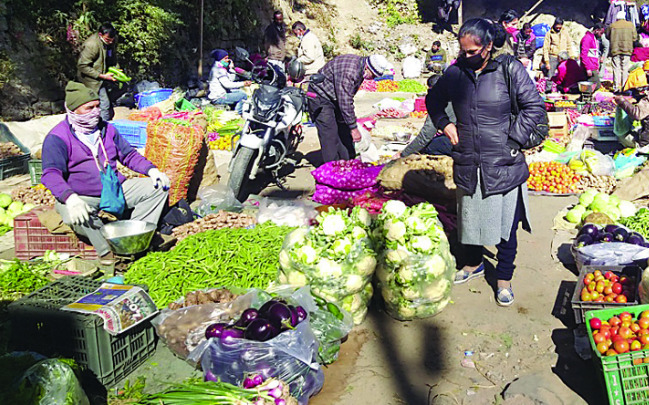Shimla: Farmers in Himachal Pradesh are not complaining as vegetable prices in Punjab, Haryana, Chandigarh and Delhi are touching the sky owing to the shortage and they are getting remunerative prices, say traders.
They say the prices will normalise after Diwali when the vegetables from the north Indian plains will start hitting the market. Currently, consumers are depending largely on the hill state.
“The price of peas has doubled with its wholesale price in Shimla currently touching Rs 150-160 per kg as against Rs 70-80 per kg in this season a year ago,” Nahar Singh Chaudhary, a wholesaler in the Dhalli market near here, told IANS.
The price of tomatoes has skyrocketed to Rs 60 per kg in Chandigarh in retail as compared to Rs 30 per kg last year. Peas, which are coming from the Karsog and Shimla areas, are selling from Rs 200-220 a kg in retail in Chandigarh.
“There is huge demand for vegetables in the plains largely owing to the festive and marriage season. Since the production in the hills has declined by 40-50 per cent and the harvesting of vegetables in the plains is yet to pick up, the farmers of Himachal Pradesh are getting handsome prices,” Dilbagh Thakur, a vegetable trader in the Solan wholesale market, told IANS.
He said a majority of tomato, capsicum, cucumber, French bean, cabbage and bottle gourd crops are reaching markets in Chandigarh, Punjab, Haryana and Delhi, commanding good prices.
He said the harvesting of tomatoes is about to be over within a fortnight. After that the crop will start arriving from Punjab and Haryana and then the prices of tomatoes will normalise.
Tomato is one of the major off season cash crops grown in the lower and mid-hills of the state. Solan district alone harvests around 1.75 lakh tonnes of tomatoes, half of the state’s overall production.
Farmers in Shimla, Kangra and Solan districts said the damage to the vegetable crops in the hill state was due to heavy rainfall and the outbreak of fungal disease that destroyed the crops more this monsoon compared to the past.
The state is also a major capsicum-producing state in the region with the bulk of the crop finding its market in Chandigarh, Delhi, Kolkata, Mumbai and Bengaluru.
It’s grown in about 1,200 hectares mainly in Solan, Shimla and Sirmaur districts. The state annually produces 100,000 tonnes of capsicum.
The wholesale price of super quality capsicum was Rs 60-Rs 70 a kg and in retail its price these days is around Rs 80 a kg in Chandigarh.
Street vendors often sell vegetables at prices over 20-30 per cent than the wholesale market.
The outbreak of fungus disease buckeye rot was maximum in tomato crops across the state due to excessive showers, a state agriculture department official told IANS.
Charan Dass Verma, a cabbage grower at Jabbarhatti on the outskirts of Shimla, said the crop is bleak this time.
“This year most of the cabbage crop was damaged due to inundation of fields with rainwater and less sunshine,” he said.
He said the wholesale rate of cabbage in Shimla is Rs 25-Rs 30 a kg, while it is Rs 40-Rs 45 in Chandigarh and Rs 50-Rs 60 in Delhi.
Last year, he said, it was less than Rs 15 a kg in the wholesale market during this period.
Likewise, seedless cucumber is selling at Rs 60 per kg in retail in Chandigarh.
Field reports say this season the damage to the capsicum crop in the state, mainly Solan and Shimla regions, is widespread due to its long-term monoculture that led to significant economic losses of up to 70 per cent.
The red and yellow capsicums that are grown in polyhouses are fetching a good price compared to the past.
Durga Devi, a vegetable grower in Kandaghat, said the red and yellow capsicums are getting good prices owing to loss of the green capsicum crop.
She said the green capsicum grown in the polyhouses is not affected by the fungus disease.
Polyhouse is a protective shade made of polythene and is used where high-value agricultural products are grown.
The government is promoting the cultivation of exotic vegetables and flowers in polyhouses that will add to the prosperity of the growers.
Vegetable production is generating revenue of Rs 3,500-Rs 4,000 crore annually and has emerged as an alternate economic activity in the agriculture sector.
The returns on off-season vegetable cultivation are very high compared to traditional food crops.
Also to cash in on the high demand and remunerative prices of organic food — be it fruits, vegetables or pulses — the state is laying emphasis on organic farming.
According to the agriculture department, 1.71 lakh farmers in Himachal Pradesh are growing chemical-free crops.
With the incentives being offered by the government, the inclination of the farmers towards natural farming has increased manifold in the state. Oriented towards chemical fertilizer-free farming, women are playing an important role in taking Himachal forward in the production of natural crops.
A seasoned journalist with over two decades of experience, Vishal writes on a wide range of subjects which include biodiversity, climate change and links between environment & development. He also covers politics and other developments in Punjab and Himachal Pradesh. He lives in Chandigarh & Shimla.



